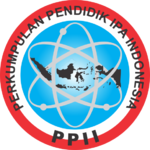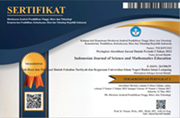Integrating seaweed ethnoscience with STEM-PjBL in renewable energy learning: Could this approach develop creativity and entrepreneurial skills?
Abstract
Keywords
Full Text:
PDFReferences
E. H. Amalu et al., “Critical skills needs and challenges for STEM/STEAM graduates increased employability and entrepreneurship in the solar energy sector,” Renew. Sustain. Energy Rev., vol. 187, p. 113776, Nov. 2023, doi: 10.1016/j.rser.2023.113776.
M. Hasan, “Sustainable Bioethanol Production: Green Energy Innovation From Residual Carrageenan in Eucheuma Cottonii Seaweed,” Am. J. Appl. Sci. Technol., vol. 4, no. 01, pp. 1–5, 2024.
N. Cokrowati et al., “Introduksi teknologi budidaya rumput laut Sargassum sp. untuk produksi bioethanol,” J. Pengabdi. Magister Pendidik. IPA, vol. 7, no. 2, pp. 663–667, 2024.
P. M. Bria and S. M. D. Kolo, “Sintesis Bioetanol dari Rumput Laut Coklat (Sargassum sp) Asal Pulau Timor Sebagai Energi Terbarukan,” Eksergi, vol. 20, no. 3, p. 162, 2023, doi: 10.31315/e.v20i3.9857.
N. U. R. HAPIZA, “Peningkatan Keterampilan Berpikir Kritis Siswa Melalui Model Pembelajaran STEM-PJBL dengan Pendekatan Etnosains pada Materi Tata Surya di MTs Negeri 1 Pekanbaru,” 2023, Universitas Islam Negeri Sultan Syarif Kasim Riau.
M. Baran, M. Baran, F. Karakoyun, and A. Maskan, “The influence of project-based STEM (PjbL-STEM) applications on the development of 21st century skills,” J. Turkish Sci. Educ., vol. 18, no. 4, pp. 798–815, 2021, [Online]. Available: https://www.tused.org/index.php/tused/article/view/1287
S. Chairunnisya, Abdurrahman, I. W. Distrik, K. Herlina, U. Rosidin, and G. F. Rabbani, “Engineering Design Process (EDP) Strategy Integrated PjBL-STEM in Learning Program: Need Analysis to Stimulate Numeracy Literacy Skills on Renewable Energy Topic,” J. Penelit. Pendidik. IPA, vol. 9, no. 12, pp. 11197–11206, Dec. 2023, doi: 10.29303/jppipa.v9i12.6088.
S. W. Al Idrus, S. K. Sa’adah, S. Sudarmin, and S. Diliarosta, “Implementasi STEM terintegrasi etnosains (Etno-STEM) di Indonesia: Tinjauan meta analisis,” J. Inov. Pendidik. Kim., vol. 15, no. 4, pp. 2778–2791, 2021.
N. Khoiri, S. Ristanto, and A. F. Kurniawan, “Project-Based Learning Via Traditional Game in Physics Learning: Its Impact on Critical Thinking, Creative Thinking, and Collaborative Skills,” J. Pendidik. IPA Indones., vol. 12, no. 2, pp. 286–292, 2023, doi: 10.15294/jpii.v12i2.43198.
A. Ghafar, “Convergence between 21st century skills and entrepreneurship education in higher education institutes,” Int. J. High. Educ., vol. 9, no. 1, pp. 218–229, 2020, doi: 10.5430/ijhe.v9n1p218.
M. Lynch, U. Kamovich, K. K. Longva, and M. Steinert, “Combining technology and entrepreneurial education through design thinking: Students’ reflections on the learning process,” Technol. Forecast. Soc. Change, vol. 164, p. 119689, 2021, doi: 10.1016/j.techfore.2019.06.015.
G. Boldureanu, A. M. Ionescu, A. M. Bercu, M. V. Bedrule-Grigoruţă, and D. Boldureanu, “Entrepreneurship education through successful entrepreneurial models in higher education institutions,” Sustain., vol. 12, no. 3, p. 1267, 2020, doi: 10.3390/su12031267.
S. K. Sa’adah, Sudarmin, and Diliarosta, “Pembelajaran Dengan Pendekatan Stem Terintegrasi Science Entrepreneurship Untuk Mengembangkan Karakter Kewirausahaan,” J. Inov. Pendidik. Kim., vol. 15, no. 1, pp. 2778–2791, 2021.
W. Sumarni, S. Mursiti, and S. S. Sumarti, “Students’ innovative and creative thinking skill profile in designing chemical batik after experiencing ethnoscience integrated science technology engineering mathematic integrated ethnoscience (ethno-stem) learnings,” in Journal of Physics: Conference Series, IOP Publishing, 2020, p. 22037.
S. N. Izzah and S. Wardani, “Analysis of Science Concept Mastery, Creative Thinking Skills, and Environmental Attitudes After Ethno-STEM Learning Implementation.,” Int. J. Instr., vol. 16, no. 3, 2023.
E. P. Dewy, B. Haryanto, and E. F. Fahyuni, “Ethno-STEM to Develop Student’s Entrepreneurial Characters at Islamic Boarding School,” KnE Soc. Sci., pp. 156–166, 2022.
P. Aswirna, F. E. Putri, and R. Jannah, “Stem-Based Trait Treatment Interaction (Tti) Model: Rumah Gadang Architecture To Students’Critical and Creative Thinking Skills,” in Proceedings of Imam Bonjol …, 2023, pp. 87–103. [Online]. Available:https://ibicie.uinib.ac.id/index.php/ibicie/article/view/51%0Ahttps://ibicie.uinib.ac.id/index.php/ibicie/article/download/51/47
W. O. Pratiwi, P. Pramudiyanti, and R. Perdana, “STEM-Based Science E-Module: Is It Effective to Improve Students’ Creative Thinking Skills?,” J. Ilm. Pendidik. Fis., vol. 8, no. 1, pp. 79–89, 2024.
L. Puspita et al., “PBL-STEM Integrated Interactive E-Module in Improving Creative Thinking Skills and Collaboration Skills: Needs Analysis in Biology Education,” in E3S Web of Conferences, EDP Sciences, 2024, p. 4009.
G. N. Rivière et al., “Toward waste valorization by converting bioethanol production residues into nanoparticles and nanocomposite films,” Sustain. Mater. Technol., vol. 28, p. e00269, 2021.
DOI: http://dx.doi.org/10.24042/ijsme.v8i1.25642
Refbacks
- There are currently no refbacks.
Copyright (c) 2025 Unit Riset dan Publikasi Ilmiah Fakultas Tarbiyah dan Keguruan Universitas Islam Negeri Raden Intan Lampung

This work is licensed under a Creative Commons Attribution-ShareAlike 4.0 International License.

Indonesian Journal of Science and Mathematics Education is licensed under a Creative Commons Attribution-ShareAlike 4.0 International License.




